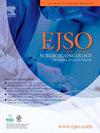Revisiting the paradigm: Asymptomatic high-grade endometrial cancer diagnosis is not associated with improved outcomes
IF 2.9
2区 医学
Q2 ONCOLOGY
引用次数: 0
Abstract
Objective
To compare the survival of women with high grade endometrial cancer between asymptomatic and women presenting bleeding symptoms.
Design
An Israel Gynecologic Oncology Group multi-center retrospective cohort study.
Methods
The study included women who underwent surgery for high-grade endometrial cancer. We compared outcomes between women presenting with postmenopausal bleeding and asymptomatic women diagnosed with high-grade endometrial cancer. Recurrence-free, disease-specific and overall survival were assessed using the Kaplan Meier method and compared using the log-rank test. Risk factors for recurrence and death were evaluated using Cox regression analysis; the primary exposure variable assessed was the presence of postmenopausal bleeding.
Results
Of the 584 women with high-grade histology, 498 (85.3 %) presented with postmenopausal bleeding and 86 (14.7 %) were asymptomatic. The median follow-up was 52 months (12–120 months). There was no difference in recurrence-free survival between women diagnosed with postmenopausal bleeding and asymptomatic women (70.1 % vs.64.6 % at 5 years, p = 0.35, respectively). There were no significant differences in disease-specific survival (66.3 % vs. 64.2 % at 5 years, p = 0.83) or in overall survival (56.4 % vs. 58 % at five years, p = 0.55) between study groups. The multivariate Cox regression analysis did not reveal any significant association between postmenopausal bleeding and survival.
Conclusion
In this study, the diagnosis of high-grade endometrial cancer in asymptomatic women was not associated with earlier disease stage at diagnosis. In women with incidental ultrasonographic findings of a thickened endometrium or polyp, routine invasive evaluation may be unnecessary.
回顾范式:无症状的高级别子宫内膜癌诊断与预后改善无关
目的比较无症状和有出血症状的高级别子宫内膜癌患者的生存率。设计以色列妇科肿瘤组多中心回顾性队列研究。方法研究对象为接受手术治疗的高级别子宫内膜癌患者。我们比较了绝经后出血妇女和诊断为高级别子宫内膜癌的无症状妇女的结局。使用Kaplan Meier方法评估无复发、疾病特异性和总生存期,并使用log-rank检验进行比较。采用Cox回归分析评估复发和死亡的危险因素;评估的主要暴露变量是绝经后出血的存在。结果584例高级别组织学患者中,498例(85.3%)出现绝经后出血,86例(14.7%)无症状。中位随访时间为52个月(12-120个月)。诊断为绝经后出血的妇女和无症状妇女的无复发生存率无差异(5年时70.1% vs. 64.6%, p = 0.35)。在疾病特异性生存率(5年时66.3% vs. 64.2%, p = 0.83)和总生存率(5年时56.4% vs. 58%, p = 0.55)两组间无显著差异。多变量Cox回归分析未显示绝经后出血与生存之间有任何显著关联。结论在本研究中,无症状女性高级别子宫内膜癌的诊断与诊断时的早期疾病阶段无关。在妇女偶然超声检查发现子宫内膜增厚或息肉,常规侵入性评估可能是不必要的。
本文章由计算机程序翻译,如有差异,请以英文原文为准。
求助全文
约1分钟内获得全文
求助全文
来源期刊

Ejso
医学-外科
CiteScore
6.40
自引率
2.60%
发文量
1148
审稿时长
41 days
期刊介绍:
JSO - European Journal of Surgical Oncology ("the Journal of Cancer Surgery") is the Official Journal of the European Society of Surgical Oncology and BASO ~ the Association for Cancer Surgery.
The EJSO aims to advance surgical oncology research and practice through the publication of original research articles, review articles, editorials, debates and correspondence.
 求助内容:
求助内容: 应助结果提醒方式:
应助结果提醒方式:


